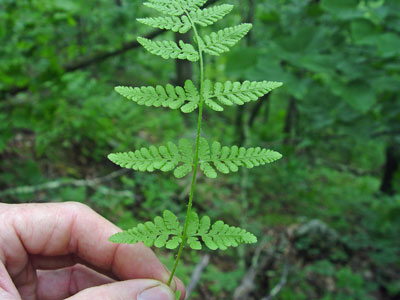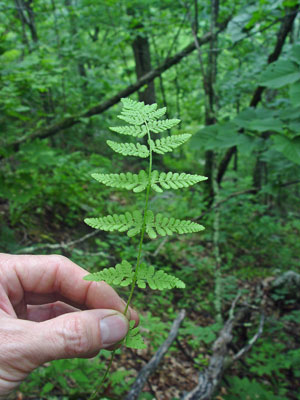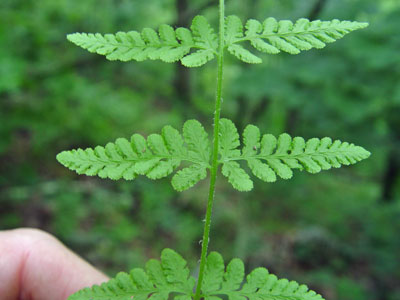DACF Home → Bureaus & Programs → Maine Natural Areas Program → Communities, Plants, and Animals → Rare Plants → Woodsia obtusa

Woodsia obtusa (Spreng.) Torr.
Blunt-lobed Woodsia
- State Rank: S1
- Global Rank: G5
- State Status: Threatened
Habitat: Rocky woods and ledges or dry wooded slopes. [Rocky summits and outcrops (non-forested, upland); Hardwood to mixed forest (forest, upland)]
Range: Nova Scotia and Maine to Wisconsin and south to Georgia, Alabama, and Texas. Also in Alaska and British Columbia. More common to the south but rare in the northern part of its range.

Aids to Identification: Cliff ferns (Woodsia) are largely slender ferns of ledges, cliffs, and talus slopes. They are recognized by their distinctive indusium (covering over the sporangium) that is lancerate into slender filaments. All of Maine's other species of cliff ferns, including W. alpina and W. glabella, have an articulated petiole, i.e., the petioles break at the same point so that all of the persistent petiole bases are the same height. This is not the case in Woodsia obtusa. This scaly and pubescent fern has persistent petiole bases of various lengths. Woodsia obtusa is also the largest cliff fern in Maine with leaf blades 8-60 cm long that are 2.5 times divided.
Ecological characteristics: Ecological relationships in Maine are not well known.
Phenology: Fronds evergreen. Produces new leaves throughout the season.

Family: Woodsiaceae
Synonyms: Maine and New England pouplations represented by ssp. obtusa. Synonyms include Physematium obtusum (Spreng.) Hook.; Polypodium obtusum Spreng.
Known Distribution in Maine: This rare plant has been documented from a total of 8 town(s) in the following county(ies): Kennebec, Oxford, York.
Reason(s) for rarity: Northeastern limit of range.
Conservation considerations: Known populations are small and subject to the vagaries of small populations like random fluctuations or localized disturbance events.